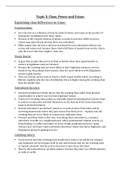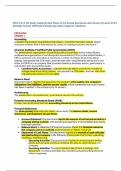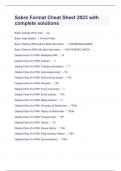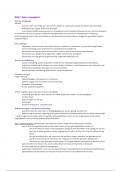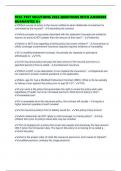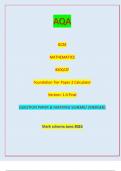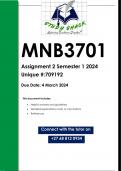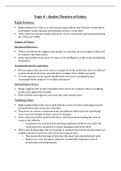Topic 3: Class, Power and Crime:
Explaining class differences in crime:
Functionalism:
See’s the law as a reflection of society’s shared values, and crime as the product of
inadequate socialisation into these values
Because of the complex division of labour in modern societies, different social
classes may split off and develop their own subculture
Miller argues that the lower class has developed its own subculture with its own
norms and values and, because these clash with those of mainstream society, this is
why the lower class has a higher crime rate
Strain theory:
Argues that people take part in deviant activities when their opportunities to
achieve in legitimate ways are blocked
Because the working class are more likely to have legitimate means to success
blocked (e.g. educational achievement), they are more likely to seek illegitimate
means to gain success
They use deviant means such as fraud or theft to gain wealth which, according to
Merton, explains why the rate of utilitarian crime is higher among the working class
than the middle class
Subcultural theories:
Started from Merton’s Strain theory that the working class suffer from blocked
opportunities to achieve success from legitimate means
Cohen see’s working-class youths as culturally deprived meaning they lack the ways
to achieve in education and find themselves at the bottom of the status hierarchy –
leads to status frustration
Deviant subcultures are formed/ joined as a result of status frustration and by
inverting mainstream values they gain status from their peers – explains why the
working class are more likely to commit non-utilitarian crime
Cloward and Ohlin built on this idea describing three subcultures; a criminal
subculture in stable w/c neighbourhoods (offers professional criminal careers e.g.
drug dealing), a conflict subculture in areas of high population turnover (gang
violence and ‘turf wars’) and a retreatist subculture (those who fail in legitimate and
illegitimate means of gaining success)
Labelling theory:
Focus on how and why working-class people have come to be labelled as criminal
and emphasise the stereotypes held by law enforcement that see the working class
as ‘typical criminals’ and the power they have to give them that label
They’re often described as ‘problem makers’ because they don’t see official statistics
as valid or useful
, o Instead, they are seen as a topic whose construction we must investigate by
studying the power of law enforcement agencies to label the working-class as
criminal
Marxism, class and crime:
All laws are for the benefit of the bourgeoisie and so criminal law reflects their
interests and follows their ideology
Personal violence is dangerous; the ruling class control agencies such as the police,
known as RSA
Criminal law therefore operates to protect the powerful and maintain false class
consciousness
Bonger argues that capitalism is based upon competition and greed and this forms
people’s attitudes to life
o Poor people are driven to crime by their desperate conditions
Dominant Hegemony:
Ruling class values imposed on the population are known as hegemony
The ruling class impose values through agencies such as the media, police and
education
o Forms the framework for society and laws are built upon in a democracy
Forced onto the people so they believe they are agreeing to it as a result of their own
belief which, in reality, is the interests of the ruling class
Crime and Control:
Ruling class diverts attention away from themselves
Crime supports the ideology of capitalism as it diverts attention away from the
exploitation of capitalism and focuses attention on the evil nature of crime
o Justifies heaving policing of W/C areas and ‘stop and searches’ of young
people
For Marxists, the structure of capitalist society explains crime
Their view of crime has 3 main elements; criminogenic capitalism, the state and law-
making and the ideological functions of crime and law
Criminogenic Capitalism:
Marxists argue crime is inevitable in capitalism because capitalism is criminogenic –
it causes crime
Capitalism exploits the w/c which is damaging to them and may lead to a rise in
crime
o Crime may be the only way to obtain consumer goods – utilitarian crime
o Alienation and lack of control may lead to aggression – non-utilitarian crime
But crime is just committed by the w/c
Explaining class differences in crime:
Functionalism:
See’s the law as a reflection of society’s shared values, and crime as the product of
inadequate socialisation into these values
Because of the complex division of labour in modern societies, different social
classes may split off and develop their own subculture
Miller argues that the lower class has developed its own subculture with its own
norms and values and, because these clash with those of mainstream society, this is
why the lower class has a higher crime rate
Strain theory:
Argues that people take part in deviant activities when their opportunities to
achieve in legitimate ways are blocked
Because the working class are more likely to have legitimate means to success
blocked (e.g. educational achievement), they are more likely to seek illegitimate
means to gain success
They use deviant means such as fraud or theft to gain wealth which, according to
Merton, explains why the rate of utilitarian crime is higher among the working class
than the middle class
Subcultural theories:
Started from Merton’s Strain theory that the working class suffer from blocked
opportunities to achieve success from legitimate means
Cohen see’s working-class youths as culturally deprived meaning they lack the ways
to achieve in education and find themselves at the bottom of the status hierarchy –
leads to status frustration
Deviant subcultures are formed/ joined as a result of status frustration and by
inverting mainstream values they gain status from their peers – explains why the
working class are more likely to commit non-utilitarian crime
Cloward and Ohlin built on this idea describing three subcultures; a criminal
subculture in stable w/c neighbourhoods (offers professional criminal careers e.g.
drug dealing), a conflict subculture in areas of high population turnover (gang
violence and ‘turf wars’) and a retreatist subculture (those who fail in legitimate and
illegitimate means of gaining success)
Labelling theory:
Focus on how and why working-class people have come to be labelled as criminal
and emphasise the stereotypes held by law enforcement that see the working class
as ‘typical criminals’ and the power they have to give them that label
They’re often described as ‘problem makers’ because they don’t see official statistics
as valid or useful
, o Instead, they are seen as a topic whose construction we must investigate by
studying the power of law enforcement agencies to label the working-class as
criminal
Marxism, class and crime:
All laws are for the benefit of the bourgeoisie and so criminal law reflects their
interests and follows their ideology
Personal violence is dangerous; the ruling class control agencies such as the police,
known as RSA
Criminal law therefore operates to protect the powerful and maintain false class
consciousness
Bonger argues that capitalism is based upon competition and greed and this forms
people’s attitudes to life
o Poor people are driven to crime by their desperate conditions
Dominant Hegemony:
Ruling class values imposed on the population are known as hegemony
The ruling class impose values through agencies such as the media, police and
education
o Forms the framework for society and laws are built upon in a democracy
Forced onto the people so they believe they are agreeing to it as a result of their own
belief which, in reality, is the interests of the ruling class
Crime and Control:
Ruling class diverts attention away from themselves
Crime supports the ideology of capitalism as it diverts attention away from the
exploitation of capitalism and focuses attention on the evil nature of crime
o Justifies heaving policing of W/C areas and ‘stop and searches’ of young
people
For Marxists, the structure of capitalist society explains crime
Their view of crime has 3 main elements; criminogenic capitalism, the state and law-
making and the ideological functions of crime and law
Criminogenic Capitalism:
Marxists argue crime is inevitable in capitalism because capitalism is criminogenic –
it causes crime
Capitalism exploits the w/c which is damaging to them and may lead to a rise in
crime
o Crime may be the only way to obtain consumer goods – utilitarian crime
o Alienation and lack of control may lead to aggression – non-utilitarian crime
But crime is just committed by the w/c


